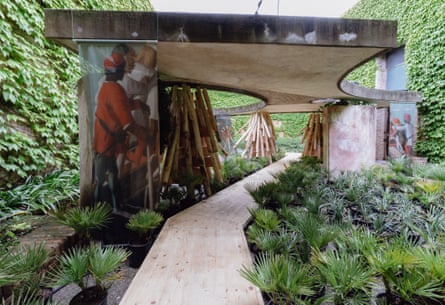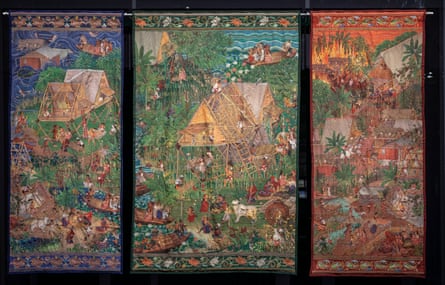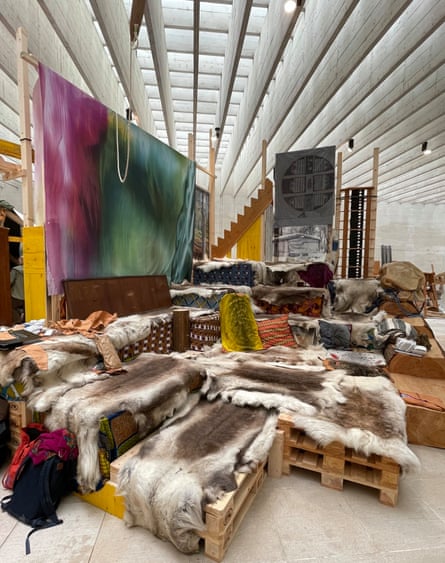A faceted brick wall stands in the middle of Venice’s Arsenale, like a sharply creased origami screen, blocking the route of visitors to this year’s Architecture Biennale. As you get closer, it looks like a rubble tapestry, with pieces of crushed brick and coloured glass emerging from its gnarled surface like great chunks of mineral nougat. Fine geometric patterns are etched across its facets, adding an air of handmade embroidery.
On a wall nearby hang images that explain the origins of this arresting barrier: a reproduction of a 17th-century map of the coasts of Africa and Brazil, a slave-trading ship’s logbook, and a piece of woven raffia from The Kingdom of Kongo. The Brazilian-Paraguayan architect Gloria Cabral and Congolese artist Sammy Baloji have fused these sources to craft a powerful monument to colonial extraction, forced migration, and the debris of empire: the rugged aggregate is demolition waste salvaged from Brussels, the imperial Belgian capital partly built on the brutal rape of the Congo.
At once tactile, seductive and unsettling, this imposing partition sets the tone for one of the most challenging, multilayered biennales yet, which puts Africa in the spotlight for the first time. It is an intentionally difficult show that explores the toxic landscapes and social scars that riddle the continent’s postcolonial lands, while also offering a glimpse of more hopeful futures brewing among the youthful population. It is a welcome wake-up call, opening a window on to a kaleidoscope of places and topics that have long been overlooked by mainstream architectural culture – as well as framing familiar topics, such as decarbonisation, in a fresh new light.
“The black body was Europe’s first unit of energy,” says Lesley Lokko, the Ghanaian-Scottish curator of this year’s exhibition, titled The Laboratory of the Future. “When we talk about decarbonisation, we are not only looking at it through a scientific, quantitative lens. It is intimately entwined with decolonisation.”
She is standing at the entrance to the show, surrounded by a gaggle of European newspaper critics – mostly elderly white men, who have spent their careers reviewing biennales curated by mostly elderly white men, featuring mostly elderly white male architects. In its 18th edition, this year’s show is a necessary corrective. It features a majority of exhibitors from Africa, or the diaspora, a 50-50 gender balance, and an average age of 43 – positively adolescent in the architectural profession. The result can be an arduous thing to digest, but one that rewards patience and close inspection. As Lokko warns: “It’s an exhibition that requires a certain amount of energy to understand. We hope people will take the time.”
There are not many buildings to look at, but there are plenty of videos, research projects and mixed-media installations that occupy what Lokko calls the “productive edge” of architecture, where it meets the worlds of landscape, ecology, policy, finance, data, public health, AI, heritage, history, conflict and identity, to name just a few of the topics consumed by her voracious multidisciplinary appetite – some of which struggle in their translation to an exhibition format.

Resource extraction, bodily and mineral, is a recurring theme. It is poetically explored by Zimbabwe-born designer Thandi Loewenson in a series of carvings, etched into slabs of industrial graphite, which hang on the wall of the central pavilion like a shimmering apparition. Alongside a video, her piece investigates the mechanisms of mining graphite, used in the production of lithium-ion batteries and driven by insatiable demand for electric vehicles in the global north. “In the transition to renewable energies for some,” she writes, “new sites of extraction, exploitation and expropriation are forged for others.”
Spanish architect Andrés Jaque, working with a group of South African activists, picks up similar themes in an immersive, narrated installation in the Arsenale, challenging what they call architecture’s “problematic addiction to shininess”. They put New York’s Hudson Yards, a billionaires’ playground where haircuts cost $800, in their line of fire, explaining how the slick corporate mirage is the product of “transnational extractivism”. The buildings’ stainless steel cladding, they argue, is only made possible by the large mobilisation of chromite, extracted from the earth of the Great Dyke of Zimbabwe. Its shine is produced by the abrasive properties of ilmenite, mined from Xolobeni on the Eastern Cape of South Africa, while the project was built on railway lands, which used cobalt extracted from the Nyungu mines of Zambia. The manufactured shininess, they reveal in an animated tableau, is created at the expense of a lifetime of toxic dustiness on the other side of the planet.
A more optimistic world is shown in the dazzling visions of Nigerian artist Olalekan Jeyifous, who has concocted an alternative solar punk history of post-independence Africa. His psychedelic sci-fi images and models, set in a fictional departure lounge, imagine a techno-ecological retro future forged from the ruins of colonial rule, with a thrilling array of zero-emissions rapid transport systems, algal energy plants and hover ships straight from an afro-Jetsons – with snazzy costumes to match. Other counterfactual histories take a darker turn, such as in Robots of Brixton, a powerful allegory for police brutality in 1980s London, or Liam Young’s dystopian scenes of carbon-capturing machines covering our smog-smothered planet.

Bringing an ecological perspective grounded more in the real world, US landscape architect Walter Hood presents his elegant proposals for an infrastructure of walkways and pavilions in the wetlands of South Carolina, a native landscape increasingly endangered by development. With hairy timber structures inspired by rice-toting baskets, his project draws on the culture of the enslaved Gullah Geechee people, the history of plantations, and the craft of sweetgrass baskets to form a light-touch intervention in the landscape, a one-to-one fragment of which has been built on the central pavilion’s courtyard.
Nearby, David Adjaye, the Ghanaian-British architect, presents a roomful of models of his office’s current projects, ranging from 100 hospitals in Ghana, to burial grounds in Barbados, to the giant (and controversial) national cathedral in Accra. The room comes as a refreshing salve – ah, real buildings at last! – although the slick presentation neatly airbrushes over some of the contested contexts from which these projects emerge. They could do with being viewed through a more probing political lens, which is evident elsewhere, rather than being presented as purely formal exercises. Those in search of buildings will also be pleased to see the work of Niger-based office Atelier Masomi, headed up by Mariam Issoufou Kamara, whose chalk drawings of Sahelian vernacular structures smother the walls, alongside sectional models of her housing projects.

There is plenty more to be absorbed by, and not just focused on Africa – from Arinjoy Sen’s beguiling embroidered triptych, made with Bengali women, of Marina Tabassum’s low-cost shelters in Bangladesh, to Alison Killing’s chilling film of her work mapping Uyghur detention camps in Xinjiang. But one big element is missing. For a biennale focused on Africa, it seems oddly blinkered not to shed any critical light on the gargantuan projects being built by other countries across the continent, most notably China, which alone has constructed 15 national parliaments, multibillion dollar railways, highways and ports and entire new cities from scratch. Much has been written about the geopolitical implications of this “debt-trap diplomacy”, but the architectural reality on the ground has received little attention. It seems architecture’s centre will continue to be subsumed by faceless global contractors, while architects are busy fiddling around the edges.
Outside the scope of the main exhibition, the national pavilions are the usual mixed bag, more like Eurovision than ever. Uruguay has gone full techno, presenting a high-octane three-part digital opera about the country’s forestry law (with strobe warnings aplenty). Not to be outdone, France has built a glittering hemispherical disco ball theatre, to host performances questioning identity, gender and colonial heritage. The British have also joined the musical fray, pumping out a booming soundtrack of garage and grime that echoes across the Giardini, accompanying an entertaining archival film of ritual and dance.
“We wanted people to hear the pavilion before they see it,” says co-curator Meneesha Kellay, “and make it bang.” While the British pavilion is often full of too many ideas, this time the curators have shown welcome restraint, treating it more like an art exhibition than the usual research-on-the-wall architecture show. Each room features an object or installation by a different artist, referencing various aspects of disaporic culture in the UK – from a gigantic bulbous domino, to a scene of domestic fragments smothered in fragrant blue Angolan soap. Another room features an ethereal cast-aluminium screen, while a fourth displays a beautiful woven web, referencing Yoruba and Cherokee traditions. Still, with all the emphasis on sculptural objects, it feels like it would be more at home at the Crafts Council gallery than an architectural biennale.


